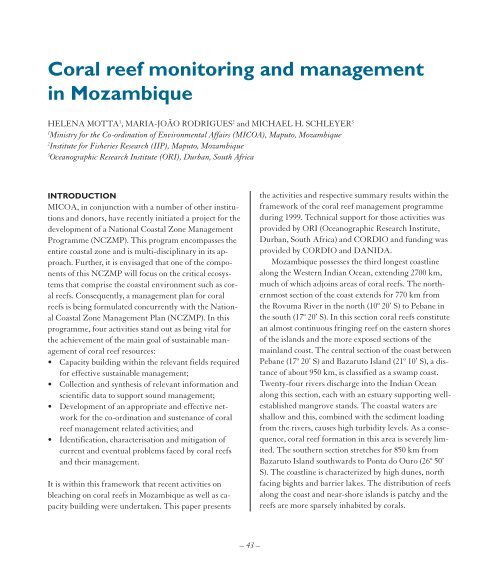Create successful ePaper yourself
Turn your PDF publications into a flip-book with our unique Google optimized e-Paper software.
Coral reef monitoring and management<br />
in Mozambique<br />
HELENA MOTTA 1 , MARIA-JOÃO RODRIGUES 2 and MICHAEL H. SCHLEYER 3<br />
1<br />
Ministry for the Co-ordination of Environmental Affairs (MICOA), Maputo, Mozambique<br />
2<br />
Institute for Fisheries Research (IIP), Maputo, Mozambique<br />
3<br />
Oceanographic Research Institute (ORI), Durban, South Africa<br />
INTRODUCTION<br />
MICOA, in conjunction with a number of other institutions<br />
and donors, have recently initiated a project for the<br />
development of a National Coastal Zone Management<br />
Programme (NCZMP). This program encompasses the<br />
entire coastal zone and is multi-disciplinary in its approach.<br />
Further, it is envisaged that one of the components<br />
of this NCZMP will focus on the critical ecosystems<br />
that comprise the coastal environment such as coral<br />
reefs. Consequently, a management plan for coral<br />
reefs is being formulated concurrently with the National<br />
Coastal Zone Management Plan (NCZMP). In this<br />
programme, four activities stand out as being vital for<br />
the achievement of the main goal of sustainable management<br />
of coral reef resources:<br />
• Capacity building within the relevant fields required<br />
for effective sustainable management;<br />
• Collection and synthesis of relevant information and<br />
scientific data to support sound management;<br />
• Development of an appropriate and effective network<br />
for the co-ordination and sustenance of coral<br />
reef management related activities; and<br />
• Identification, characterisation and mitigation of<br />
current and eventual problems faced by coral reefs<br />
and their management.<br />
It is within this framework that recent activities on<br />
bleaching on coral reefs in Mozambique as well as capacity<br />
building were undertaken. This paper presents<br />
the activities and respective summary results within the<br />
framework of the coral reef management programme<br />
during 1999. Technical support for those activities was<br />
provided by ORI (Oceanographic Research Institute,<br />
Durban, South Africa) and <strong>CORDIO</strong> and funding was<br />
provided by <strong>CORDIO</strong> and DANIDA.<br />
Mozambique possesses the third longest coastline<br />
along the Western Indian Ocean, extending 2700 km,<br />
much of which adjoins areas of coral reefs. The northernmost<br />
section of the coast extends for 770 km from<br />
the Rovuma River in the north (10º 20’ S) to Pebane in<br />
the south (17º 20’ S). In this section coral reefs constitute<br />
an almost continuous fringing reef on the eastern shores<br />
of the islands and the more exposed sections of the<br />
mainland coast. The central section of the coast between<br />
Pebane (17º 20’ S) and Bazaruto Island (21º 10’ S), a distance<br />
of about 950 km, is classified as a swamp coast.<br />
Twenty-four rivers discharge into the Indian Ocean<br />
along this section, each with an estuary supporting wellestablished<br />
mangrove stands. The coastal waters are<br />
shallow and this, combined with the sediment loading<br />
from the rivers, causes high turbidity levels. As a consequence,<br />
coral reef formation in this area is severely limited.<br />
The southern section stretches for 850 km from<br />
Bazaruto Island southwards to Ponta do Ouro (26º 50’<br />
S). The coastline is characterized by high dunes, north<br />
facing bights and barrier lakes. The distribution of reefs<br />
along the coast and near-shore islands is patchy and the<br />
reefs are more sparsely inhabited by corals.<br />
– 43 –


















